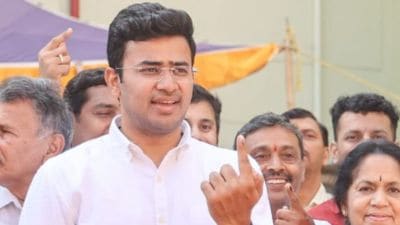- India
- International
Getting there a long trek for a phone call: This number is not reachable
Would a couple be alive had they not gone up a hill to make a phone call, asks an Odisha village, which has no mobile network or landline
 Villagers have to walk 2 km down this trek, and up the hill. (Source: Express photo by Debabrata Mohanty)
Villagers have to walk 2 km down this trek, and up the hill. (Source: Express photo by Debabrata Mohanty)
It is 4 pm and Pongalapadar village in Kandhamal district, Odisha, is wet and muddy from the intermittent showers since morning. Six villagers step out of their huts, ready to brave the drizzle. Their old Nokia phones tucked into their trousers, the men walk through bushes on a 2-km muddied track, careful not to trip over the rocks on the way. Their steps are slow, as they keep an eye on snake burrows, with one villager recounting how he saw a krait slither past the other day. But the group also wants to hurry, lest they are spotted by a fox or jackal in the densely forested area. It is only when they reach the foot of a 100-foot-tall hillock that they heave a sigh of relief.
They now begin their steep climb, stopping midway on a patch which has little foliage. “Maybe we can catch a signal here,” says Rahul Nayak, a 25-year-old among the group. The men take out the phones from their pockets and move around the patch, their eyes fixed on their phones to look for signal strength. “Got it,” exclaims Rahul, his phone managing a signal under a tree. He dials a friend in Bhubaneswar.
Others by now have also managed to place a phone call. They spend nearly half an hour there, before beginning their return journey to their huts.
[related-post]
This walk is the highlight of their day. Pongalapadar is disconnected from the world. The closest and only mobile tower, operated by BSNL, is 3 km away. The signals it sends are blocked by dense forests and the mountains that surround the village — one of the hundred villages in Kotgarh block of Kandhamal, a Maoist hinterland. The two Reliance towers in the block are not in operation.
No family in Pongalapadar has a landline connection, as laying cables through the forests was deemed “difficult” by BSNL, the only telecom operator in the area. Of the hundred-odd families, all Dalit Christians, only a few own cell phones, but to make a call, they have to climb one of the nearby hills to catch the signal. “Otherwise, we only listen to songs on the phone,” laughs Samson Rupamajhi.

Trilochan Singh, block development officer, says only two gram panchayats of the 11 in Kotgarh have mobile coverage. His office — a run-down building with an asbestos roof — too has mobile connectivity for only “two-three hours a day”. “An assistant engineer in our office learnt about his mother’s death three days after she passed away,” says Singh.
Kandhamal district telecom officer Brundaban Behera admits the network is bad. “We will add two towers in the block,” he promises.
It’s an assurance that has come too late for 50-year-old Dhuba Nayak and his wife Bhubudi, allegedly killed by the anti-Maoist Special Operations Group (SOG) on July 26.
It was a Sunday afternoon, the time of the week the couple would call up their three sons living in other places. Three others accompanied the Nayaks to a hill to call up their relatives. When the three returned home after making their calls, the Nayaks were still on the hill. Half an hour later, villagers recall hearing gunshots. The police later explained the deaths of Nayak and his wife as “a successful encounter with Maoists”.
Since then, villagers fear going to the hills to make phone calls. “We are all scared,” says Tarabati Challanseth, a housewife.
It was around six years ago, when mobile phones started trickling into Pongalapadar, that villagers started going up the hills to make calls.
“We always go in groups and before sunset for fear of animals in the forests. We go up once a week,” says Philomena Challanseth.
Since no mobile phone owner can receive a call in the village, the trek is important. “We may be lucky to receive a call while on the hill though,” says Challanseth.
Lack of mobile phone connectivity is just one of the aspects of Pongalapadar’s inaccessibility. Villagers must brave thick forests and snake burrows even to avail basic amenities. Like walking almost three hours to Kotgarh block office to collect their monthly quota of subsidised rice. Or walking 30 km to the ‘nearest’ government hospital. “No ambulance can ever come to our village. When someone falls sick, we tie a sheet to bamboo sticks to make a sling and carry the patient,” says Anand Challanseth.
The only government institution is an upper primary school whose headmaster Arun Kumar Pradhan can afford to go home in the neighbouring block once a week. For water, villagers depend on a mountain stream as there is no deep tubewell or handpump. Electricity, which came here three years ago, is erratic. No home has a toilet either.
After the Nayaks’ death, villagers have thrown their weight behind Rahul, the eldest son of the Nayaks, who has filed a petition before the Odisha Human Rights Commission, demanding Rs 50 crore compensation and action against the SOG.
The National Human Rights Commission has also taken suo motu notice of the incident and served notice to the state government. “Had there been telecom network in our village, my parents would never have been killed,” says Rahul.
Apr 26: Latest News
- 01
- 02
- 03
- 04
- 05







































